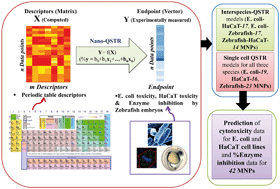Second generation periodic table-based descriptors to encode toxicity of metal oxide nanoparticles to multiple species: QSTR modeling for exploration of toxicity mechanisms†
Abstract
The application of in silico methods in the risk assessment of metal oxide nanoparticles (MNPs) and data gap filling has found profound usability. Followed by the success of periodic table-based descriptors in the modeling study, we have reported here a pool of second generation periodic table descriptors for better understanding the mechanism of toxicity of MNPs towards three species, namely, E. coli, a human keratinocyte cell line (HaCaT) and zebrafish embryos. These descriptors are easily derived from the molecular formula and periodic table in no time and can be used in models with a prediction ability similar to or even better than those involving quantum chemical descriptors and physicochemical indices. Employing the developed 1st and 2nd generation periodic table-based descriptors, we have developed single species quantitative structure–toxicity relationship (QSTR) models and interspecies quantitative structure–toxicity–toxicity relationship (i-QSTTR) models to understand the relationship of the toxicities of metal oxide nanoparticles with different species along with the identification of the major mechanism(s) for such toxicities. These models further helped in extrapolating toxicity when the data for one species are available and the data for other species are unavailable. Further, we have made predictions for a set of 42 true external MNPs, employing all three QSTR models individually, the toxicity data for all three species using a two-stage prediction confidence check through the applicability domain and the “prediction reliability indicator”. The developed models interpreted that the oxidation state of the metal, the electronegativity of the metal oxide and the core count of the metal play substantial roles in the toxicity mediation of the MNPs irrespective of the species and response. Along with the first generation descriptors, the newly developed second generation periodic table-based descriptors can encode the toxicity features of MNPs efficiently as compared to classical quantum chemical descriptors involving time-consuming computations and physicochemical descriptors involving experimental tests.



 Please wait while we load your content...
Please wait while we load your content...
